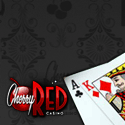In Blackjack at a casino, the dealer faces one to seven players from behind an arc-shaped table. Each player plays his hand independently against the dealer. At the beginning of each round, the player places a bet in the “betting box” and receives an initial hand of two cards. The object of the game is to get a higher card totaling than the dealer’s hand, but without going over 21, which is called "busting" or "breaking.”
Cards with a number 2 to 10 printed on them count as that value; the jack, queen, and king (also known as “face cards”) count as 10; the ace card can be either 1 or 11 according to the player’s choice. The player goes first and plays his hand by taking additional cards if he desires. If he goes over 21 points, he “busts” and automatically loses the hand and his bet.
Then the dealer plays his or her hand. If the dealer busts, he loses to all remaining players who have cards whose values are equal to or below 21. If neither busts, the higher hand total wins. If a player ties with the dealer, the hand is a “push”, also known as a “standoff”, and the player’s bet is returned (this means player does not lose his bet, but wins nothing either; this rule does apply in the US as well as in European casinos). It is possible for the dealer to lose to some players but still beat other players in the same round.
Example of a Blackjack game. The top half of the picture shows the beginning of the round, with bets placed and an initial two cards for each player. The bottom half shows the end of the round, with the associated losses or payoff. Cards are dealt in three ways, either from one or two hand-held decks, from a box (known as a “shoe”) containing four to eight decks, or from a shuffling machine.
When dealt by hand, the player’s two initial cards are usually face-down, while the dealer has one face-up card called the “upcard” and one face-down card called the “hole card.” (In European blackjack, the dealer’s hole card is not actually dealt until the players all play their hands.) When dealt from a shoe, all player cards are normally dealt face-up, with minor exceptions.
It shouldn’t matter to the non-expert player whether his cards are dealt face-down or face-up since the dealer must play according to predetermined rules. If the dealer has less than 17, he must hit. If the dealer has 17 or more, he must stand (take no more cards), unless it is a “soft 17″ (a hand that includes an ace valued as “11,” for example a hand consisting of Ace+6, or Ace+2+4). With a soft 17, the dealer follows the casino rules printed on the blackjack table, either to “hit soft 17″ or to “stand on all 17′s.”
Normally, the highest possible hand is a “blackjack” or “natural,” meaning an initial two-card total of 21 (an ace and a ten-value card). A player who is dealt a blackjack is an automatic winner, unless the dealer also has blackjack, in which case the hand is a “push” (tie). When the dealer’s upcard is an ace, the player is allowed to make a side bet called “insurance,” supposedly to guard against the risk that the dealer has a blackjack (i.e., a ten-value card as his hole card). The insurance bet pays 2-to-1 if the dealer has a blackjack. Whenever the dealer has a blackjack, he wins against all players except those who also have a blackjack (a “push”).
The minimum and maximum bets are posted on the table. The payoff on most bets is 1:1, meaning that the player wins the same amount as he or she bets. The traditional payoff for a player blackjack is 3:2, meaning that the casino pays $3 for each $2 originally bet, but many casinos today pay less at some tables.



